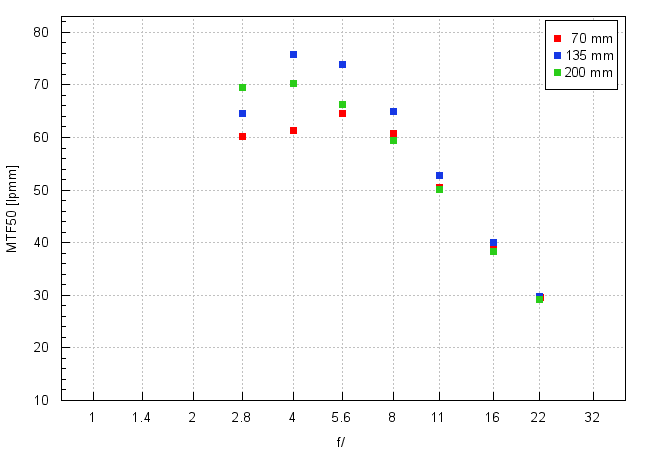Sony FE 70-200 mm f/2.8 GM OSS II
4. Image resolution
Let's check how the Sony FE 70-200 mm f/2.8 GM OSS II compares – its result in the frame centre at 70, 135, and 200 mm focal lengths presents a graph below.

Please Support UsIf you enjoy our reviews and articles, and you want us to continue our work please, support our website by donating through PayPal. The funds are going to be used for paying our editorial team, renting servers, and equipping our testing studio; only that way we will be able to continue providing you interesting content for free. |
- - - - - - - - - - - - - - - - - - - - - - - - - - - - - - - - - - - - - - - - - - - - - - - -
Not so long ago we hand an opportunity to test the Nikkor Z 70-200 mm f/2.8 VR S. We used the Nikon Z7 body with a sensor of 45.7 Mpix so a tad higher resolution than that of the Sony A7R II. Linear density of pixels in the Nikon is higher by just less than 4% so MTF50 function values are also a tad higher (about 2-3 lpmm) That knowledge enables us to compare both systems, at least in some areas.
First of all, it seems the constructors' approach was a bit different in every case. The Nikkor fared the best at 70 mm, exceeding 80 lpmm in that place. The new Sony is the best at longer focal lengths – at 135 mm it exceeds a very high level of 80 lpmm and at 200 mm it more or less brushes against it.
The mere fact that a zoom lens is able to reach near 80 lpmm, only a bit lower than official resolution records set by the best fixed-focal lenses, speaks volumes about the quality of this instrument.
In fact The Sony FE 70-200 mm f/2.8 GM OSS II deserves a standing ovation for its performance in the frame centre.
Will the edge of the frame be equally good? First, let's focus on the edge of the smaller APS-C sensor.

Once again the best results you see in the 135-200 mm focal range and the 70 mm fares a bit weaker. Does this fact give you any reasons to complain? Not at all. Many primes wouldn't be ashamed of resolution results which exceed 60 lpmm at the shortest focal length up from the maximum relative aperture.
As we are near the ending of this chapter we should also should deal with the performance on the edge of full frame.

In this case the 135 mm focal length sticks out in a positive way because it fares sensationally well. Even though the Sony 70-200 mm is a zoom lens, it is able to defeat with ease many f/2.5-2.8 primes we've recently tested.
The same we can say about its performance at the 200 mm focal length. Resolution results exceeding 60 lpmm already up from the maximum relative aperture are no mean feat. It's worth reminding here that the Nikkor Z 70-200 mm f/2.8 VR S on the edge of its a tad more pixel-packed sensor wasn't able to exceed 60 lpmm in a noticeable way at any focal length.
Compared to that even the weakest focal length of the Sony, the 70 mm, looks good although its MTFs don't get over 50 lpmm. You simply can't find a weak point here!
To sum up we don't hesitate to say that, when it comes to resolution, the new Sony FE 70-200 mm f/2.8 GM OSS II is an outstanding lens, providing you a sensational image quality at every focal length and across the frame. It really performs as befits a high quality, top-of-the-range journalistic instrument.
At the end of this chapter traditionally we present crops taken from photos of our resolution testing chart which were saved as JPEG files along the RAW files, used for the analysis above
| Sony A7R III, JPEG, 70 mm, f/2.8 |
 |
| Sony A7R III, JPEG, 135 mm, f/4.0 |
 |






